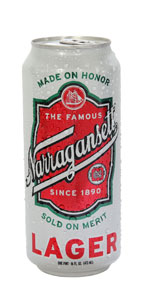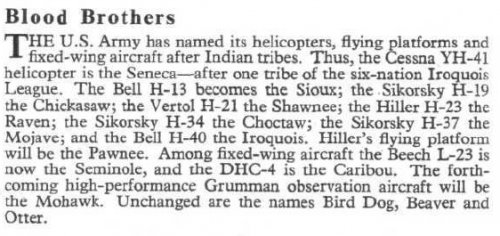I've read that Arapaho was not an official name for the Bell ARH-70. If that's true, I wonder if the name Arapaho will be given to the Sikorsky S-97?
You are using an out of date browser. It may not display this or other websites correctly.
You should upgrade or use an alternative browser.
You should upgrade or use an alternative browser.
US Army Aircraft Naming Policy
- Thread starter Triton
- Start date
- Joined
- 4 July 2010
- Messages
- 2,217
- Reaction score
- 2,100
I don't know whether the name Arapaho was officially adopted or not before the program was canned, but I doubt it would be immediately recycled given its association with the ARH-70. At any rate, S-97 won't get an official nickname unless the Army buys some. For now they're sticking to the "Raider" marketing name.Triton said:I've read that Arapaho was not an official name for the Bell ARH-70. If that's true, I wonder if the name Arapaho will be given to the Sikorsky S-97?
Moose said:I don't know whether the name Arapaho was officially adopted or not before the program was canned, but I doubt it would be immediately recycled given its association with the ARH-70. At any rate, S-97 won't get an official nickname unless the Army buys some. For now they're sticking to the "Raider" marketing name.
Just wishful thinking on my part.
marauder2048
"I should really just relax"
- Joined
- 19 November 2013
- Messages
- 3,157
- Reaction score
- 774
Anasazi!
Arikara
- Joined
- 16 April 2008
- Messages
- 8,347
- Reaction score
- 10,147
sferrin said:Ute.
That could be the name for the UH-60 replacement. In Australia and New Zealand, ute is an abbreviation for "utility" or "coupé utility" to describe passenger vehicles with a cargo tray in the rear.
- Joined
- 3 June 2011
- Messages
- 17,287
- Reaction score
- 8,963
TomS said:
Dang. Seems like the more prominent tribes have been used at one point or another. Wouldn't mind a Cheyenne 2 if they bought the S-97 though.
sferrin said:Dang. Seems like the more prominent tribes have been used at one point or another. Wouldn't mind a Cheyenne 2 if they bought the S-97 though.
Maybe if your name selection criterion for Army rotorcraft is belligerent tribes from the Plains Indian Wars.
- Joined
- 25 June 2009
- Messages
- 13,711
- Reaction score
- 2,871
1°) I seem to recall that Arapaho was a perfectly official (albeit short-lived) allocation. I'll have to dig an article from AW&ST about that.
2°) The U.S. Army NEVER reallocated an Indian tribe's name to a new type, therefore the hopes of ever seeing a new Ute, Cheyenne, Mescalero or whatever seem pretty slim to me...
2°) The U.S. Army NEVER reallocated an Indian tribe's name to a new type, therefore the hopes of ever seeing a new Ute, Cheyenne, Mescalero or whatever seem pretty slim to me...
- Joined
- 3 June 2011
- Messages
- 17,287
- Reaction score
- 8,963
Triton said:sferrin said:Dang. Seems like the more prominent tribes have been used at one point or another. Wouldn't mind a Cheyenne 2 if they bought the S-97 though.
Maybe if your name selection criterion for Army rotorcraft is belligerent tribes from the Plains Indian Wars.
Which prominent non-belligerent tribes have never had anything named for them?
sferrin said:Which prominent non-belligerent tribes have never had anything named for them?
Boeing CH-47 Chinook
- Joined
- 3 June 2011
- Messages
- 17,287
- Reaction score
- 8,963
Triton said:sferrin said:Which prominent non-belligerent tribes have never had anything named for them?
Boeing CH-47 Chinook
- Joined
- 25 June 2009
- Messages
- 13,711
- Reaction score
- 2,871
To the best of my knowledge there have never been Army aircraft or helos by the names Papoose, Cherokee, Navajo, Pocono or Pawnee (all were used by Piper for civilian types). Now of course some of these were belligerent tribes and some were not.
Skyblazer said:To the best of my knowledge there have never been Army aircraft or helos by the names Papoose, Cherokee, Navajo, Pocono or Pawnee (all were used by Piper for civilian types). Now of course some of these were belligerent tribes and some were not.
Papoose comes from the Algonquian papoos meaning "child". I think you meant Palouse.
The "American Indian Wars" page on Wikipedia has a number of Native American tribes and bands that have not had fixed-wing or rotary-wing aircraft named for them:
http://en.wikipedia.org/wiki/American_Indian_Wars
Some additional tribe and Native American band names for consideration: Chickamauga, Seminole, Winnebago, Muscogee (
Don't forget that the CH-54 Tarhe and UH-60 Black Hawk are named for Native American leaders. Red Cloud, Sitting Bull, Crazy Horse, Geronimo (Goyathlay), Tecumseh, Two Moons, Leschi, Lone Horn, Cochise, Rain-in-the-Face, Sealth (Seattle), Spotted Elk, Pontia were Native American leaders during the American Indian Wars.
The Sikorsky S-97 Raider could be named for Native American tribes who served in the United States Army Indian Scouts/United States Scouts: Narragansett, Mohegan, Navajo, Pawnee, Arikara, Crow, Seminole, Shoshone, Eskimo, Tonkawa, Lipan, and Delaware.
Sources:
http://plainshumanities.unl.edu/encyclopedia/doc/egp.war.022
http://en.wikipedia.org/wiki/United_States_Army_Indian_Scouts
Sources:
http://plainshumanities.unl.edu/encyclopedia/doc/egp.war.022
http://en.wikipedia.org/wiki/United_States_Army_Indian_Scouts
- Joined
- 25 June 2009
- Messages
- 13,711
- Reaction score
- 2,871
Triton said:Skyblazer said:To the best of my knowledge there have never been Army aircraft or helos by the names Papoose, Cherokee, Navajo, Pocono or Pawnee (all were used by Piper for civilian types). Now of course some of these were belligerent tribes and some were not.
Papoose comes from the Algonquian papoos meaning "child". I think you meant Palouse.
The "American Indian Wars" page on Wikipedia has a number of Native American tribes and bands that have not had fixed-wing or rotary-wing aircraft named for them:
http://en.wikipedia.org/wiki/American_Indian_Wars
Some additional tribe and Native American band names for consideration: Chickamauga, Seminole, Winnebago, Muscogee (Creek), Arikara, Jicarilla, Yavapai (Tonto), Yuma, Cahuilla, Yakama (formerly spelled Yakima), Nisqually, Muckleshoot, Puyallup, Klickitat, Coeur d’Alene, Spokane, Palouse, Paiute, Hualapai, Snake, Modoc, Nez Perce, Bannock, Shoshone, Crow, Yaqui, Delaware (Lenape), Ojibwe, Shawnee, Oneida, Onondaga, Seneca, Tuscarora, Cayuga, Miami, Kickapoo, Wabash, Havasupai, Hopi, Goshute, Blackfoot, Pueblo, Acoma, Isleta, Jemez, Zuni, Wyandot, Potawatomi, Tlingit, Pima, Tulalip, Salish, Omaha, Yurok, Klamath, Quinault, Lummi.
Thanks for researching the subject. Please note that Shawnee, Creek and Seneca have already been used by the Army, for the H-21, H-67 and H-41, respectively.
Skyblazer said:Thanks for researching the subject. Please note that Shawnee, Creek and Seneca have already been used by the Army, for the H-21, H-67 and H-41, respectively.
Thank you, I will strike those names from my list.
Kiltonge
Greetings Earthling
- Joined
- 24 January 2013
- Messages
- 449
- Reaction score
- 577
Found this snippet from Flight in August 1957, which appears to be the date from which the tribal naming policy was applied.
So Pawnee was also a planned assignment, for this.
Presumably the types listed didn't have a common-name prior to these assignments? Also interesting that they didn't override existing names.
http://www.flightglobal.com/pdfarchive/view/1957/1957%20-%201058.html
So Pawnee was also a planned assignment, for this.
Presumably the types listed didn't have a common-name prior to these assignments? Also interesting that they didn't override existing names.
http://www.flightglobal.com/pdfarchive/view/1957/1957%20-%201058.html
Attachments
- Joined
- 25 June 2009
- Messages
- 13,711
- Reaction score
- 2,871
Kiltonge said:So Pawnee was also a planned assignment, for this.
How could I forget about the Hiller Pawnee? I could kick myself sometimes! Thanks for the reminder... :
Kiltonge
Greetings Earthling
- Joined
- 24 January 2013
- Messages
- 449
- Reaction score
- 577
And a different twist on US Army "names"; unofficial names daubed on helicopters.
A sample from a book, from the publisher's site.
http://hellgatepress.com/sites/hellgatepress.com/files/pages_1-20.pdf
A sample from a book, from the publisher's site.
http://hellgatepress.com/sites/hellgatepress.com/files/pages_1-20.pdf
9,000 Lbs Of Romp + Stomp FBtry 79 AFA AH-1G 71-72 gun
- Joined
- 11 March 2012
- Messages
- 3,016
- Reaction score
- 2,680
To the best of my knowledge there have never been Army aircraft or helos by the names Papoose, Cherokee, Navajo, Pocono or Pawnee (all were used by Piper for civilian types). Now of course some of these were belligerent tribes and some were not.
Piper did build a single prototype of their Papoose, two-seat trainer, but never put it into production
- Joined
- 4 May 2008
- Messages
- 2,440
- Reaction score
- 673
Interesting story. I'm surprised that the workers' union fought against it. It may have required less work to assemble, but if in the process you develop a product that is sold by the thousands, you may actually add jobs.
If a competitor had developed a similar airplane and had it been successful, the end result would have been a loss of market share and work at the Piper factories. Seems like a dangerous attitude. That is not to say that workers don't need protection; but stymieing manufacturing advances is not the answer.
If a competitor had developed a similar airplane and had it been successful, the end result would have been a loss of market share and work at the Piper factories. Seems like a dangerous attitude. That is not to say that workers don't need protection; but stymieing manufacturing advances is not the answer.
- Joined
- 9 October 2009
- Messages
- 19,766
- Reaction score
- 10,213
Unfortunately Unions don't always act rationally and/or in the best interest of their members.
Similar threads
-
New designation for the latest Mangusta/Mongoose upgrade
- Started by Nico
- Replies: 0
-
-
LOH, ASH, AHIP, ARH and AAS. US Army Scout Helicopter Programmes.
- Started by 500 Fan
- Replies: 33
-
News: New office to take charge of naming U.S. military aircraft
- Started by fightingirish
- Replies: 0
-
Sikorsky S-70/S-78/H-60 family name, nicknames, commercial names etc
- Started by Nico
- Replies: 2


